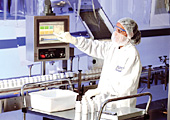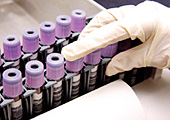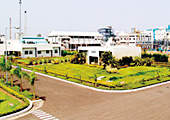 |
| India tops in the number of US FDA-certified
factories outside the US |
For every
10 drug master filings (a regulatory filing needed for an active
pharmaceutical ingredient, API, or bulk drug manufacturer) received
by the us Food and Drug Administration (FDA), four come from India.
And of every 20 abbreviated new drug applications (ANDAs), or
an application to seek an approval to market generic drugs in
the US, five come from India too.
India is also home to the largest number of US FDA-certified
factories outside of the US. In other words, India is a global
pharmaceuticals factory that is getting bigger and bigger. Five
years ago, annual exports were about Rs 10,000 crore; today, it's
a little over Rs 20,000 crore. "Costs of production are a
by-product of efficient manufacturing, and here Indian pharma
companies are globally competitive," says Satish Reddy, MD
& COO of Dr Reddy's Labs (DRL). "In fact, in a few products,
Indian manufacturers are among the lowest-cost producers."
What makes Indian drug companies so competitive? Years of reverse
engineering branded drugs (until 2005, India only recognised process
patents and not product patents) has resulted in superlative expertise
in chemistry. To quickly tell you what that means, such an expertise
allows drugmakers to come up with superior processes, scale up
in terms of both range and speed of reactions, improve yields,
and package drugs in a variety of forms. In a fiercely competitive
industry like pharma, the know-how makes a big difference and
the larger players see it as a way to strengthen their place in
global markets.
| SECTORAL SNAPSHOT |
»
India's pharma industry is the fourth largest by
volume and 13th largest by value. In just five years, exports
have more than doubled to Rs 21,578 crore
» India
accounts for 40 per cent of the US drug master filings (a
regulatory filing needed for bulk drug makers)
» India
has the largest number of US FDA-approved manufacturing sites
outside of the US
» A quarter
of ANDA filings (abbreviated new drug applications to market
generic drugs) in the US are from India |
Take Sun Pharmaceuticals, for instance. Six years ago, international
markets accounted for a quarter of its revenues, but today they
fetch 40 per cent. Formulations exports accounted for just 7 per
cent of revenues back then, today they make up 29 per cent. The
Mumbai-based company is now adding manufacturing capability in
'complex' areas such as controlled substances and injectibles,
which have relatively few competitors. "Steps are being taken
to eventually be completely integrated for controlled substances,"
says a company spokesperson.
Another Mumbai-based major Cipla too has been growing exports
at 40-50 per cent a year over the last six years. And it is the
development and manufacturing partner of choice for generic companies
like IVAX and Watson, and has formulations/bulk drug supply arrangements
with eight generic players in the us. Some other global generic
firms have chosen to acquire companies. A case in point: Mylan's
recent acquisition of Hyderabad-based Matrix Labs.
 |
| Five years ago, India's pharma exports were
about Rs 10,000 crore; today it's doubled to over Rs 20,000
crore |
India's biggest pharma company, Ranbaxy, which has also been
under tremendous cost pressure, is banking on process efficiencies
to boost its bottom line. "Optimising manufacturing costs
is one of our key areas of focus. We continuously evaluate and
implement newer technologies and leverage our strong scientific
capabilities to squeeze costs and extract greater value and efficiencies
from our manufacturing operations," says the company's CEO
& MD, Malvinder Mohan Singh. In fact, Ranbaxy has created
a separate global business unit (GBU) for bulk drugs so that the
back-end can be looked at in a holistic manner and "make-or-buy"
decisions can be evaluated as a means of containing costs. DRL
too is investing in new cutting-edge infrastructure that will
increase automation and reduce the possibility of human error,
thereby "significantly improve our competitiveness in the
global market", says Reddy.
Then, there is Nicholas Piramal (NPIL), which seems poised to
emerge as an important player in the custom manufacturing space.
In June this year, it acquired Pfizer's Morpeth facility, marking
its third acquisition in the UK after its acquisition of Rhodia's
inhalation anaesthetics business in December 2004 and Avecia's
custom manufacturing business in December 2005. The Morpeth facility
comes with a buyback agreement with Pfizer valid until November
2011, giving NPIL potential revenues of $350 million (Rs 1,610
crore). With the acquisition of Morpeth, NPIL becomes the biggest
supplier (in terms of spend) within Pfizer's global contract manufacturing
network.
The China Factor
 |
| Indian companies continue to have a headstart,
particularly in the highly developed and regulated markets |
What is, however, becoming increasingly important is the China
factor. Ranbaxy's Singh feels China is emerging as a strong player
in the global pharma industry. "We see this as an opportunity
to source API and intermediates from them as a means to lower
our own cost of production." While sourcing from China may
be the right thing to do at the moment, all seem quite wary of
China. Says Amar Lulla, Jt Managing Director, Cipla: "There
is a very serious threat from China. Not only are they fast learners,
but they also have a very supportive government," helping
with everything from infrastructure to soft loans. Which is why,
Lulla feels, it is time the Indian government began following
the Chinese example. The only hurdle China seems to be facing
on its way into the bulk drugs or formulations market is regulatory
compliance. But it is only a matter of time before China crosses
this hurdle as well.
But then as Ranbaxy's Singh points out, Indian companies continue
to have a headstart particularly in the highly developed and regulated
markets, where a strong front-end and integrated play remain the
key factors determinants of competitive advantage. What is more,
as Reddy notes, "Putting our analytical capabilities to work
and pushing our research teams to go beyond infringement and create
proprietary products does give us a global edge." That means
a global blockbuster drug should soon be coming out of India.
|







